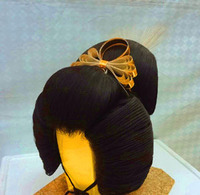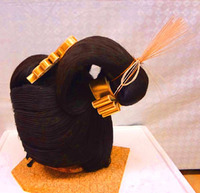

Total:131items
- Pottery & Porcelain (18)
- Lacquerware (4)
- Glasswork (2)
- Wood & Bamboo Work (19)
- Leather Work (1)
- Papermaking (13)
- Textile (20)
- Dyeing products (5)
- Masonry (1)
- Metal Work (11)
- Stationery (4)
- Livingware (3)
- Accessory (4)
- Toys & Entertainment (14)
- Interior (2)
- Other crafts (10)

 |
Main Production Site:Hiroshima |
 《Characteristics》
《Characteristics》Essentially Kamoji indicates women’s hairpiece, but broadly includes wig. Kamoji produced in Yano-cho, Hiroshima is well known nationwide.
Natural resources of Yano-cho, such as clay, a necessary item to remove oil from materials, abundant water of creeks from the valley is suitable for rinsing kamoji, helped Kamoji industry thriving in the city.
The peak season of the industry was the early 20 century. At that time, 70% of the national production volume was produced in Yanocho. In addition, there was Kamoji market in the city. 80% of residents involved in the Kaomoji industry.
[A traditional craft designated by Hiroshima Prefecture]
(Source: Yano Kominkan, the Hiroshima City of the Future Foundation)
Translation: Yuka Toguchi, reviewed by Chan Yitin

| Materials | Hairs, Clay to get rid of sebum |
|---|---|
| Crafting Processes | 1. Removing Oil from Hairs
Craftspeople steam Tamage (tangled hairs) in a kettle with water and Higedo (clay) to remove unnecessary oil and dusts. While the hairs are still hot, they hit the Tamage with Nukiita (a tool) so that the clay can absorb the oil and dusts. 2. Tokisoroe (Combing and Arranging) Next, craftspeople get dry the oil-removed Tamage under the sun, comb the hairs, and make all of them uniform length roughly. 3. Tsunosashiage (Tsunosa Finishing) After Tokisoroe, craftpeople comb the Tamage again with other wooden combs called Kanegushi and Arame to make all of them uniform length. The hair divided into the quantity that can be held in one hand is called Tsunosa. 4. Dying After the process 3, hairs are dyed beautiful black by boiling with water in a kettle. 5. Color Fixing and Adding Lustre To prevent the color fading, dyed Tsunosa is boiled with a chemical called Roha(made from copperas) and left overnight to fix the color. Then they are rinsed under running water. Lastly, they are boiled in another kettle with caustic soda again for adding lustre. 6. Nukiji (Trussed Hairs) After finishing all dying process, craftspeople comb Tsunosa with another comb called Hakogushi and make all of them uniform length with a tool called Sun-ita. Then, they divide the hairs into the quantity that can be held in one hand. The bunch of hair is called Nukiji, which will be further processed to various Kamoji products. |
| History | Essentially Kamoji is used as a tress by women; they add it to their own hair when they wear a certain Japanese hair style.
According to the history, producing Kamoji was established by Kichibei Okanda from Yano, approximately 350 years ago, beginning of the Edo period. The most prosperous time of Kamoji industry in Yanocho was the first 30 years of the 20 centuries. In 1927, a record says 430 Kamoji factories operated and 1,386 people involved in the industry. Today, the traditional Kamoji is not produced anymore. There is one sole company which inherits the traditional techniques of Yano Kamoji (a traditional crafts manufacturer designated by the Hiroshima prefectural government in 1991, and its products are acknowledged as one of the specialty of Hiroshima). Their products, medical wigs and hair extensions are now manufactured by factories in China and Korea, based on their technical heritage. |
◆Exhibition / Showcase
You can see real Kamoji at Yano Kominkan (Yano Community Center).
Opening Hour:
8:30a.m. ~10:00 p.m.
Closed on Tuesday, public holidays
*We close on the following weekday if a public holiday is on Tuesday:
Peace memorial day (6th August)
And during New Year holiday (29th December ~3rd January )
Admission Fee:
Free
Address:
5-24-2 Yano-nishi Aki-ku, Hiroshima 736-0085 Japan
Tel/ Fax: +81-82-888-0044
Assistance needed? For inquiries in English:
JTCO Contact Form
Your inquiries will be forwarded by JTCO in Japanese to the organization you wish to contact.
Please specify the name of the craft/art you wish to inquire about.



